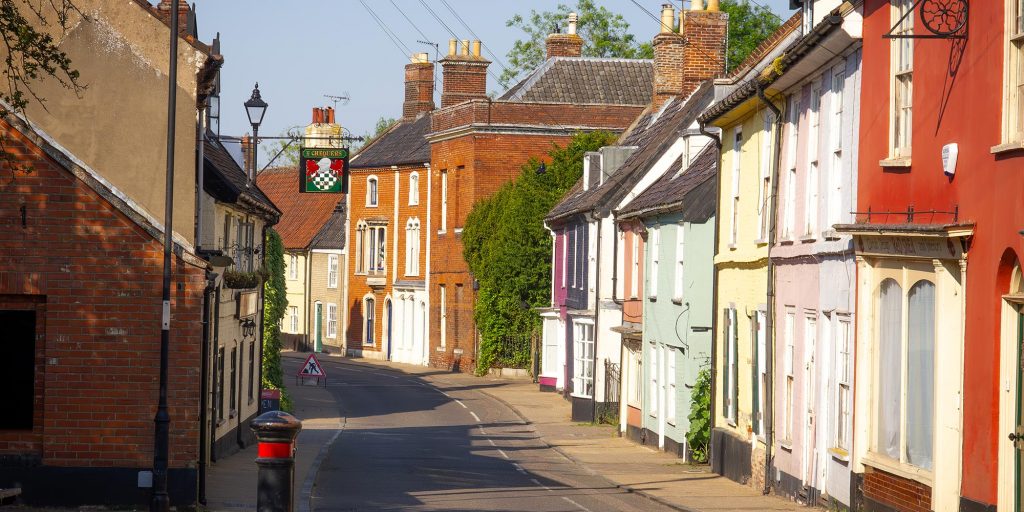The War Years
The first of a story about the 446th Bomb Group and their experiences in the Bungay area. This installment details the war years. From the book “The 446th Revisited” by Ed Castens edited by Steve Roat.
The Boys from America in Bungay
In 1939, a war broke out in Europe that would soon envelope the entire globe. In December of 1943, a group of aviators and their ground support crew would arrive in Bungay to do their part in ridding the world of Hitler’s terror.
We soon became “Anglophiles.” Robert Browning wrote “Oh, to be in England, Now that April’s there!” Unfortunately, we arrived in November. It was cold, damp and wet – there was mud, mud and more mud.
Flixton and Station 125 were about two miles from Bungay. It was a pleasant and charming little village located 114 miles from London on the Waveney Valley branch of the LNER (London and North East Railway). It took about three and half hours to get to London. When the train stopped we never knew where we were. Station signs had been removed so German paratroopers would be confused if they ever dropped into England. Norwich was 15 miles away and the Liberty Run went there every night.
East Anglia bulged out into the North Sea and was a checkerboard of air bases known as ‘The Unsinkable Aircraft Carrier.’ We were only seven minutes away from German bomber and fighter bases – not a comforting thought.
There was so much history in the area. Settlers in Jamestown, Virginia came from Bungay and sections of East Anglia. John Harvard and Thomas Paine were from the area. We found Bungay to be a charming, sleepy little town. There was a tranquillity even with a war going on. Yet it had seen stirring times and the history of England could be verified in it.
It was a market town for the agricultural area, the staple industry of the county. The soil was not particularly rich, but the farmers earned a reputation for the cultivation of the type of ground. Wheat and barley were the chief crops. We thought Brussels sprouts were the leading crop. The farmers were proud of their horses, black-faced sheep and large black pigs. We found the townspeople friendly and hospitable. The local boys and girls did not take long to get to know the Yanks greeting them with the familiar “Any gum, chum?”
The weather, as a rule, was dry and pleasant with the yearly average rainfall only about 24 inches. However, some of us thought the weather was abominable. Samuel Johnson observed in 1758: “when two Englishmen meet their talk is of the weather.” The construction of our air field and depot was undertaken by the British early in 1942. However, with the shortage of men, materials and space there were problems. Finally, American and British workers joined hands and the typical 8th Air Force bomber base took shape. It was carefully blended into the countryside, with the major sites dispersed to guard against enemy attack.
The barracks were dispersed in wooded areas to minimize damage and loss of life. The recreational sites, usually close to the living quarters, contained the mess halls, showers, the PX and clubs for the officers and enlisted men.
The several housing sites were separated by distances ranging up to a half-mile or more. It was estimated for a man working on the flight line to get from the place where he worked, ate and slept, he would travel an average of seven miles per day. We traveled on trucks, bicycles and shanks’ mare.
The technical site, adjacent to the runways, was the location of the repair and supply services. About a half-mile away was the headquarters site, the core of the Group Operations, Intelligence and Administrative services were located there. Most of the buildings were the prefabricated type erected on concrete foundations. Service units on the base included an ordnance company, quartermaster, signal, chemical and military police detachments. In addition to the service group headquarters and headquarters squadron there was weather, finance, gas defense and our post office.
The distinctions that separated the United States and Great Britain disappeared during the War. It was no longer hands across the ocean. There was no longer an ocean between us. We were there. By the time we hit the tight little island, there were almost a million and a half GIs there. Before the war was over, three million Americans were stationed there or passed through on the way to the Continent.
By Steve Roat

